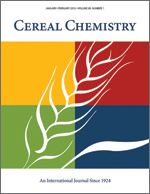
Cereal Chem 72:187-190 |
VIEW ARTICLE
Evaluation of Selected Barley Cultivars and Their Fractions for beta-Glucan Enrichment and Viscosity.
S. H. Yoon, P. T. Berglund, and C. E. Fastnaught. Copyright 1995 by the American Association of Cereal Chemists, Inc.
Two waxy hull-less (Apollo and Wanubet) and one nonwaxy hulled (Robust) barley cultivars were milled on a hammer mill, using three screens to produce two grinds (coarse and fine) of whole grain barley flour (BF). Each grind of each BF was fractionated by means of sieves and combined into four fractions (A-D, largest to smallest particle size, respectively), based on similar particle sizes and extract viscosities. Percent distribution of weight in each fraction was similar among cultivars within the same grind but differ ed significantly between the coarse and the fine grinds. Apollo and Wanubet, both waxy hull-less cultivars, had higher beta- glucan contents and extract viscosities than did the nonwaxy hulled cultivar for BF and all fractions. beta-Glucan contents and extract viscosities of all fractions of the fine grind, except D, were higher than the original BF, in all cultivars. beta-Glucan concentrations in fine-grind fractions were 1.38- to 1.88-fold greater than those of the original barley grains. Thus, milling with a hammer mill and fractionation produced fractions with higher beta-glucan and extract viscosity when compared to the original BF.